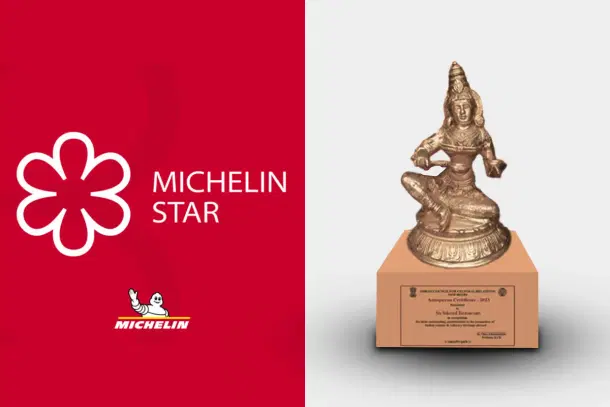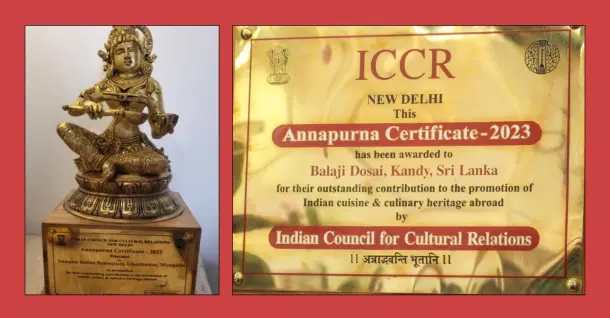Culture
Annapurna Certificates: Why India’s Michelin Stars Must Celebrate Its Full Culinary Diversity
Deviyani G
Feb 07, 2025, 01:17 PM | Updated Oct 18, 2025, 11:05 PM IST
Save & read from anywhere!
Bookmark stories for easy access on any device or the Swarajya app.


In 1897, Maharaja Sayaji Rao Gaekwad of Baroda, a man known for his wealth, cultural refinement, and passion for the arts, hosted a dinner for Maharaja Scindia of Gwalior.
The menu, remarkably, was entirely French, featuring dishes like Pure’a d’Asperges, Cauliflower a la Hollaindaise, and Pistachio Pudding.
This culinary event exemplified the political acumen of India's princely rulers, who understood that in an era when each principality wielded significant autonomous power, the dining table could serve as a sophisticated stage for diplomatic theater.
A ruler's ability to impress through hospitality, particularly through such an elaborate display of gastronomic sophistication, was a significant tool for fostering alliances and strengthening relationships.
While the specific methods of "table diplomacy" may have evolved over the past century, the fundamental principle—using food as a means of building rapport and solidifying diplomatic ties—remains remarkably consistent.
This interplay between food and diplomacy is fascinating, take the instance of Prime Minister Indira Gandhi making the ITDC open a Cypriot restaurant at The Ashok.
It happened around the time India and Cyprus were strengthening their relationship, particularly after Archbishop Makarios became Cyprus's first president in 1960. India and Cyprus have maintained a very warm relationship ever since.
More recently, at the G20 in 2023, New Delhi presented to the world a millet rich culinary extravaganza — an all vegetarian menu that showcased India’s culinary diversity and its wealth of ingredients.
Building upon this rich inheritance is the Indian Council of Cultural Relations (ICCR) and its prestigious Annapurna Certificate program.
This initiative represents India's first formal system for recognising culinary excellence in restaurants serving authentic Indian cuisine abroad, establishing a standard of distinction comparable to the internationally renowned Michelin star rating system.
Winners of the award receive a statute of Goddess Annapurna, the Hindu Goddess of food and nourishment, and a certificate that attests to the restaurants outstanding contribution to "Indian Cuisine and Culinary Heritage".

This program operates within a well-defined framework. It is exclusively open to international restaurants that have proven their expertise in bringing authentic Indian cuisine to their local communities.
To qualify, a restaurant must have been in operation for at least five years, ensuring a track record of culinary excellence and a well-established presence.
Both fine dining and all-day restaurants are eligible, regardless of the owner’s nationality, but large corporate chains are not considered. Strict compliance with local food safety and hygiene regulations is also an absolute must.
The application process begins with a submission to the relevant Indian diplomatic mission, which conducts an initial review before recommending standout candidates to the ICCR headquarters.
A specially appointed jury at ICCR makes the final decision, though a preliminary screening committee may be formed to ensure only the most deserving applications reach this stage.
This thorough evaluation process is part of an annual award cycle helping uphold consistently high standards.
For the 2023 cycle out of the 120 restaurants that had vied for the award, 6 made the final cut: Amber India (USA), Balaji Dosai (Sri Lanka), Indian Street Food & Co. (Sweden), Mumtaz Mahal Restaurant (Oman), Namaste India (Mongolia), and Naans and Curries (Costa Rica).
As of 2024, while the applications are out, winners are yet to be announced.
Need to Represent Diversity
Of the six restaurants awarded the Annapurna Certificate in 2023, all featured cuisines predominantly associated with Northern India, specifically Punjabi and Mughlai.
While undeniably delicious, this style of cooking has, unfortunately, become solely synonymous with "Indian food" in the global perception. This focus on a single region within India overshadows the country's immense culinary diversity.
The vibrant spices of the South, the unique sweets of the West, and the distinctive meat preparations of the East, while integral to the Indian palate, are often underrepresented on the international stage.
This culinary stereotyping has, regrettably, contributed to and reinforced stereotypical and sometimes racist "curry" jokes directed at Indians abroad.
Even Balaji Dosai, a Sri Lankan restaurant with clear Tamil roots and the sole 2023 awardee with an obvious South Indian influence, includes popular North Indian dishes on its menu alongside traditional South Indian fare. This further illustrates the dominance of North Indian cuisine in the global understanding of Indian food.
It is time we attempt and broaden the world’s horizons and showcase the marvels of gastronomic heritage from all the regions of Bharat.
A glimpse of this can be seen in the menu of another Annapurna certificate winner, The Indian Street Food & Co. from Sweden.
It is a bit more inclusive, featuring dishes ranging from the coasts of Konkan to that of Malabar, including Mumbai Samosas, Kerala Prawn Curry, Golden Goan Prawns, and Hyderabadi Dum Biryani.
Another issue with these certificates is that since these awards are not restricted to strictly Indian (or diaspora) owned restaurants, they may not be able to sufficiently address the matter of ‘authenticity’.
Often abroad, particularly in the West, Pakistani and Bangladeshi immigrants market their establishments as ‘Indian’ in hopes of easier recognition.
This can be witnessed almost everywhere - from London’s Southall (Little India) to Jackson Heights in Queens, New York - where restaurants owned by immigrants from our western and eastern neighbours often masquerade as Indian, benefitting from the brand recognition ‘Indian food’ has in these countries when compared to other South Asian cuisines.
How much value do these certificates hold?
After a thorough search of the social media of each of the six restaurants that received this award in 2023, it was found that only Balaji Dosai actively promoted the award ceremony on its Facebook account.
None of the remaining 5 restaurants have utilised this recognition to market themselves on online platforms - an unthinkable proposition if a restaurant was ever awarded the Michelin star.
This points towards the need for a more aggressive push when it comes to marketing the awards to increase its brand value. The ICCR can take a leaf from the Thai select programme in this regard.
The Thai SELECT Program And What India Can Learn
The Thai SELECT program is a fascinating example of how a nation can effectively promote its cuisine and culture on a global scale.
An initiative by the Thai government's Ministry of Commerce, it is basically a way to guarantee the authenticity of Thai restaurants and Thai food products both in Thailand and around the world.
One of its key strengths is the official certification it provides to restaurants that serve authentic Thai cuisine. This quality seal helps build trust among customers and ensures a consistent culinary experience worldwide.
The Thai Select program also features a tiered certification system, offering different levels of recognition, such as Signature, Classic, and Casual, to accommodate a variety of dining experiences—from fine dining establishments to more casual eateries.
ICCR could introduce a similar structure to ensure both high-end Indian restaurants but also smaller, family-run eateries receive due recognition.
Additionally, The Thai award is divided in 2 categories: Thai ready-to-eat/ready-to-cook products and Thai restaurants.
Annapurna awards can consider expanding and branching into the ready to eat category as well, fostering greater recognition for Indian consumer brands.
Standardisation and training also play a crucial role in Thai Select. The program provides chefs and restaurant owners with training and guidelines to maintain the quality and authenticity of Thai cuisine.
India could implement a similar culinary training initiative for chefs working abroad, ensuring they stay true to traditional Indian recipes while making necessary adaptations to local tastes.
On a more basic level, the Thai government has a dedicated website for the Thai select programme, featuring the restaurants that have won the recognition with their location and contact number.
In contrast, the Annapurna awards barely find mention, with just a page on the ICCR website dedicated to the 2023 awardees. The winners don't have their location, social media or numbers featured on the page, making it hard for potential customers to discover these hidden gems.
Moreover, the award ceremony in 2023 generated very limited buzz. Collaborating with food bloggers and documenting the behind the scenes could add an element of virality.
Untapped Market
While Michelin stars, awarded by the Michelin Guide—an influential global culinary ranking—are synonymous with fine dining excellence, they have yet to expand to India.
India's lack of representation in the Guide presents a significant opportunity for the Annapurna Certificate program. A void exists for a prestigious and recognized award specifically celebrating excellence in Indian cuisine. The Annapurna Certificate program has the potential to fill this gap.
The program can become the definitive mark of quality for Indian restaurants globally, effectively becoming the "Indian Michelin."
Crucially, the Annapurna Certificate can showcase the vast diversity of regional Indian cuisines, moving beyond the often-generalized perception of "Indian food" and highlighting the country's rich culinary heritage—something Michelin, with its limited geographic focus, may find challenging.
Furthermore, similar to Michelin's Bib Gourmand (special shout-out for places that offer delicious food at a reasonable price), the Annapurna Certificate can cater to diverse dining preferences with categories for fine dining, casual eateries, and even street food, recognising excellence at all levels.
The Annapurna Certificate program holds immense potential to become a powerful tool for promoting authentic Indian cuisine globally. However, to truly realize this potential, the ICCR must address several key areas.
A broader representation of India's diverse regional cuisines is crucial, moving beyond the over-reliance on Northern Indian dishes. Stricter criteria regarding ownership and a greater emphasis on "authenticity" are needed to ensure the award truly celebrates Indian culinary heritage.
This, in turn, will help boost the international profile of Indian cuisine.





